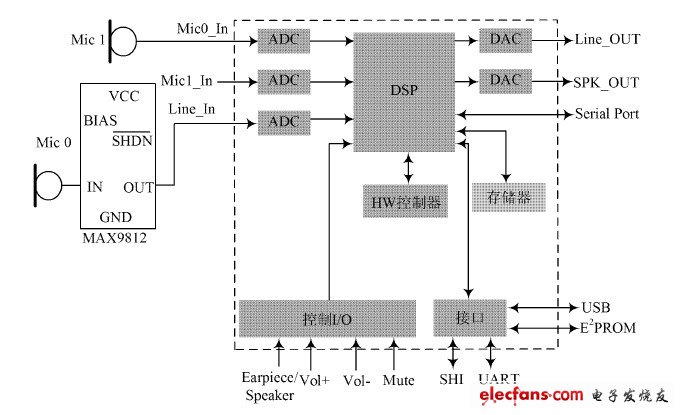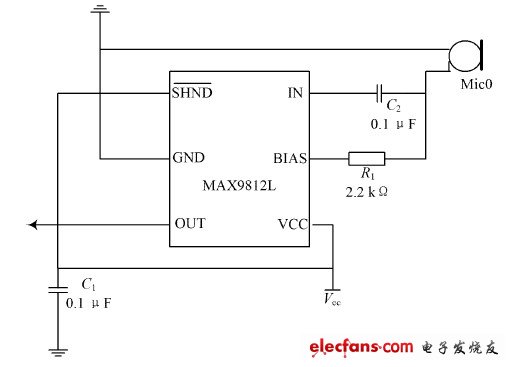introduction
Trying to filter noise from noise-polluted speech signals and improving the signal-to-noise ratio of speech signals has become an important direction in the research of speech denoising. A large number of technologies are now used to suppress noise interference in the channel to improve the quality of communication.
The system is mainly used to process the background noise of the source part. The FM1182 of American Fudi Company is adopted as the core chip, and the MAX9812L chip of MAXIM Company is used as the auxiliary chip. The circuit uses dual microphones as inputs, which are used to pick up pure noise and background noise mixed voice signals, respectively. The two signals are finally processed at the DSP chip inside FM1182 to obtain the signal after noise reduction. The DSP chip has the characteristics of good stability and high precision, and the 16-bit processor can reach the accuracy of 10-5. The power supply voltage of this system is about 3 V, and the power consumption is low. A pair of AAA batteries can be used for power supply, which fully reflects the characteristics of portability.
1 Selection of noise reduction scheme
For the design of noise-cancelling microphone systems, three options have been considered.
Option 1: Use microphone array technology. The delayed cumulative beam method is adopted to compensate the delay from the sound source to each microphone through the delay control, and correct the signal received by each microphone. This method is divided into 3 parts, namely time delay estimation, time delay compensation and accumulation part. However, the relationship between the increase of the signal-to-noise ratio and the microphone in practical applications is 10log10 M (M is the number of microphones). More microphones are required to obtain higher noise canceling performance, which is not in line with portability, energy consumption, and cost. The requirements of this design.
Option 2: Adopt dual microphone reverse noise cancellation principle. Use a microphone to pick up the voice signal with background noise and pure noise signal respectively. The two microphones are within 1 m of each other to ensure the high coherence of the noise. The signal is pre-filtered at 300 ~ 3 400 Hz first, and then the subtractor circuit is used to perform destructive processing to obtain a noise-reduced signal. The system uses ± 5 V regulated power supply. However, it was found in the test that due to the low integration level, too many devices and traces cause internal self-excited noise, line crosstalk noise, etc. to superimpose each other, and ultimately the signal quality becomes very poor. The ± 5 V power supply makes the system consume more energy and reduces flexibility.
Option 3: This option is derived from the improvement of Option 2. In order to improve the integration of the circuit, fewer components are used to achieve the noise reduction function. After comparing the comprehensive indicators of performance, price, volume, and energy consumption, FM1182 was finally selected as the core chip of the circuit. At the same time, the MAX9812L chip with high signal-to-noise ratio and low energy consumption is used in the preamplifier circuit. The increase in component integration and the reduction in the overall number greatly improve the reliability of the circuit, reduce the volume of the circuit, and increase portability. At the same time, a chip with low energy consumption is adopted, so that the circuit can be driven by a small power supply with a low current of about 3 V, and the use time is longer, and the flexibility is greatly improved. So in the end I chose option 3.
2 Hardware system design
FM1182 is the latest low-power and high-performance chip introduced by American Fudi Technology. FM1182 provides an optimized solution for the voice interface market. Applications include very low power consumption of 30 to 35 mW in a typical vehicle. There are two ways to achieve low power consumption: first, the integrated hardware accelerator helps the main digital signal processor to offload high-intensity processing, allowing the chip to work at the best speed; second, FM1182 uses Fudi Technology ’s patented AMBIN voice processing algorithm to ensure the highest s efficiency. For portable devices with limited power, FM1182 provides a suitable solution for echo cancellation and noise suppression. It has a highly integrated single chip, very low power consumption (30 ~ 35 mW), and powerful AEC (acoustic echo cancellation) (60 dB), excellent full-duplex performance, differential input / output reduces radio frequency (RF) interference, improves immunity, dynamic range control (DRC) improves sound intelligibility, side tone cancellation 25 ~ 35 dB, eliminates acoustic echo Tail length coverage: 64 ~ 100 ms, small size. Therefore, it is very in line with the original intention of the design of the portable, low consumption, high performance and low price of this circuit.
The general digital denoising process is divided into: sound pickup, amplification, anti-aliasing filtering, analog-to-digital conversion, DSP processing. This design uses FM1182 as the core processing chip and MAX9812L as the auxiliary chip. The whole working process:
First, the voice signal containing background noise is picked up by Mic0, and after passing through the high signal-to-noise ratio and low power amplifier circuit formed by the MAX9812L chip, it is sent to the FM1182 chip through the Line_In interface. The pure noise signal is absorbed by Mic1 and enters the FM1182 chip through the Mic_In interface. The two signals pass through the analog-to-digital conversion and enter the DSP chip. The code of the noise canceling algorithm is stored in the internal memory, and the DSP chip is operated by the code of the noise canceling algorithm in the memory. After being boosted by the hardware accelerator, it can greatly increase the computing speed of the DSP chip at the cost of less energy consumption. The signal processed by the DSP chip is the final signal, which is output by the digital / analog conversion chip for subsequent use, and can be used for wired or wireless communication. The structure diagram of the portable noise canceling microphone system is shown in Figure 1.

Figure 1 Structure diagram of portable noise canceling microphone system
2. 1 Front microphone amplifier circuit
The microphone preamplifier circuit is made of MAX9812L chip, built-in a single 20 dB fixed gain amplifier, small size, with industry-leading level of 100 dB power supply rejection ratio, extremely low THD + N (0.015%), 230μ A operating current. When in the off mode, the total power supply current and bias current can be reduced to 100 nA, and can work in the voltage range of 2. 7 ~ 3. 6 V, providing a high signal-to-noise ratio, low energy consumption, portable s solution. The IN pin is a signal input pin, and the sound is transformed into a weak current through the mini microphone, and the chip receives it through the IN pin. The BIAS pin is a voltage compensation pin, which can ensure the normal operation of the microphone under a variety of power supply voltages and reduce the impact of voltage fluctuations on signal processing.
The pin is used to control the running state of the control circuit.
When the pin is connected to VCC, the circuit works normally; when the
When connected to GND, the circuit is closed. Here, will
Connect to the power supply and set high level. OUT is an output pin. The signal amplified by MAX9812L is output through this interface for the next stage of circuit processing. Connect to the FM1182 chip here. The microphone preamplifier circuit is shown in Figure 2.

Figure 2 microphone preamplifier circuit
Led Ceiling Lamp,Modern Ceiling Lamps,Led Recessed Ceiling Lights,Remote Control Ceiling Lights
Changxing Fanya Lighting Co.,Ltd , https://www.fyledlights.com